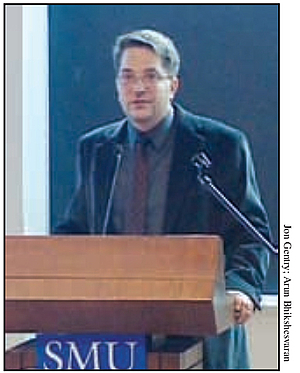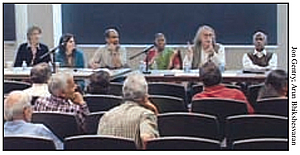
Centre of Jaina Studies Newsletter: SOAS - University of London
South Asia Research and Information Institute (SARII) and the Religious Studies Department of Southern Methodist University (SMU) organised a one-day conference on "Jainism in South India" on September 20, 2008 in Dallas, Texas. The objective of the conference was to highlight the significant influences Jainism has had on South Indian Culture. The conference was chaired by Dr Steven Lindquist of SMU. Prof. Vijayan Pillai of SARII and Dr Cordelia Candelaria, SMU's Dean of Dedman College of Humanities and Sciences, welcomed the attendees. The speakers included Dr Alvappillai Veluppillai of Arizona State University, Dr Robert Zydenbos of University of Munich, Dr Rangarajan Vijayalakshmy, retired from the International Institute of Tamil Studies, Dr Sudalaimuthu Palaniappan of SARII, Dr Lisa N. Owen of University of North Texas, and Ms Eva-Maria Glasbrenner, MA, of University of Munich. The conference was attended by over 140 persons representing the South Asian community, the SMU faculty and students as well as others. The presentations of the speakers are summarised below.
Dr Veluppillai's presentation was entitled, "Jainism: Its Origin in Eastern North India and Later Arrival and History in South India." According to Dr Veluppillai, western north India was the place where the Vedic religion originated while eastern north India was where Jainism, Buddhism and Ajivikism originated. While the Jaina tradition talks of 24 tīrthankaras, modern researchers consider only Pārśva (9th century BCE?) and Mahāvīra (6th century BCE?) to be historical figures. Since early evidence relating to Mahāvīra does not mention Pārśva, Mahāvīra can be considered to be the founder of Jainism. Jainas characterise the enlightenment of their founder as omniscience. The earliest available Jaina scriptures could be dated ca. 2nd century BCE. The essence of Jainism as a unique understanding of the reality of the world where beings are found even in the elements of nature and each being wants not to be hurt is discussed in the earliest scripture. Although Mahāvīra does not mention the Upaniṣads and the Upaniṣads do not mention Mahāvīṟa, Jainism's worldview holds karma, saṃsāra and mokṣa in common with other religions like Buddhism and the Vedic religion. Veluppillai further discussed the migration of Digambaras to South India and the Jaina schism resulting in the Digambara and Śvetāmbara sects. Finally he discussed Jainas establishing the Drāviḍa Saṅgha in Madurai in 5th century CE. The story of Tamil Caṅkam, the academy of Tamil literature, in Madurai seems to be modeled on the Jaina saṅgha.


Dr Zydenbos' talk was entitled, "Jainism in the History and Literature of Karnataka". According to Dr Zydenbos, the history of Jainism in South India is the history of Jainism in Karnataka. The history of the Digambara denomination is intimately connected with the southward migration of Jaina ascetics in pre-Christian times to the part of India that is now known as Karnataka, and Karnataka has remained the main cultural centre of Digambara Jainism ever since. Important Jaina authors in Sanskrit and Prakrit have lived and worked in Karnataka, and the first few centuries of the history of Kannada literature are dominated by Jaina authors such as Pampa, Ranna, and Ponna. Pampa, called Ādikavi, set the literary standard for Kannada. This immensely rich literature also reveals a great deal about the religious, social and political history of southern India.
Dr Vijayalakshmy's talk was entitled, "Religion: Leitmotif of Jaina Tamil Literature". According to Dr Vijayalakshmy, Jainism found its way into Tamil land as early as 2nd century BCE and has contributed greatly to Tamil language and literature. Jainas made their literature accessible to a wider audience by authoring texts in Tamil. This led to Tamils being attracted to Jainism. They also earned the patronage of Tamil kings after the 5th century CE. Jaina contribution to Tamil literature can be divided into three phases. The first phase covers the Caṅkam and post-Caṅkam period from 2nd century BCE to 6th century CE. In this period there is reference to Jainas in the Caṅkam Tamil texts but we do not have direct reference to any Jaina text. We do have, however, references to Sallekhana which was called Vaṭakkiruttal in Tamil. In the post-Caṅkam works called the Patiṉeṇkīḻkkaṇakku, we have texts like the Nālaṭiyār and the Tirukkuṟaḷ showing Jaina influence. The Cilappatikāram, the post-Caṅkam epic, has a Jaina nun, Kavunti, and Jaina Cāraṇas as characters. The second phase of Jaina influence is the Bhakti period when Śaiva Nāyaṉmār and Vaiṣṇava Āḻvārs gained royal support. Religious tolerance gave way to fanaticism. The secular love of Caṅkam poetry was used to express love between devotee and God. Jainas were ridiculed and criticised. Jainism lost its earlier influence. In the third phase, Tamil Jaina authors imported from Sanskrit and Prakrit many texts and translated them. These include works such as Cīvakacintāmaṇi, Peruṅkatai, Cūḷāmaṇi, and Nīlakēci. The leitmotif of all these texts was to propagate Jaina principles through epic literature. Cīvakacintāmaṇi (8th-9th century CE) is the best example of this genre.
Dr Palaniappan's presentation was entitled, "Going to Hell or Being Low-born: Misinterpretation of Jaina Tamil Usage and the History of Untouchability in Early South Indian Society." According to Dr Palaniappan, Tamil nationalist scholars have held that the early Tamil society was casteless. But, they have not been able to explain away the occurrence of words such as pulaiyaṉ, iḻipiṟappiṉōṉ, iḻipiṟappāḷaṉ, and iḻiciṉaṉ traditionally interpreted as low-born persons in classical Tamil literature. On the other hand, these words have led other scholars like K. K. Pillay and George Hart to state that the concept of untouchability - and hence the notion of caste - has been present from the time of Classical Tamil literature. All these scholars have failed to consider the influence of Jaina worldview reflected in the classical Tamil literature. When the classical Tamil texts are analyzed using information from the field of Jainism along with philology, Dravidian linguistics, and South Indian epigraphy, one could see that neither untouchability nor caste was indigenous to Tamil society. In fact, the word pulaiyaṉ which later came to mean 'a polluted man' originally meant 'a man who causes auspiciousness/prosperity'. Ironically, the non-violence principle of Jainism was an inadvertent catalyst in the development of violenceridden untouchability among the speakers of Dravidian languages in post-classical Tamil times.
Dr Owen's talk was entitled, "Sculpture or Architecture? Reconsidering Jaina Rock-Cut Monuments in Tamil Nadu." According to Dr Owen, there are a number of medieval Jaina sites in Tamil Nadu that feature large boulders or outcrops of stone that are carved with images of Jinas and Jaina deities. The relief carvings that constitute these sites typically span the entire surface of the boulder and are often accompanied by donative inscriptions. Given the large number of these reliefs and the fact that they are independent donations, most art historians examine them in an effort to track changes in Jaina iconography and style. This approach, however, tends to deny the efficacy of these images when viewed collectively. More importantly, it denies the ways that these images demarcate Jaina notions of sacred space. Dr Owen presented slides showing cave sites, such as Cittaṉṉavācal, followed by detailed analysis of boulder carvings at Kaḻugumalai. She demonstrated that these images clearly function collectively to identify the boulder and its surrounding environs as a place sacred to Jainas and as a place worthy of worship. She concluded that by examining the nature of the "site" rather than examining individual sculptures we could come to a better understanding of how such places functioned in their medieval context.
Ms Glasbrenner's presentation was entitled, "The Holy Jaina Field of the White Pond: Bāhubali and His Kṣetra as Reflected in the Mahāmastakābhiṣeka Ritual." According to Ms. Glasbrenner, Śravaṇa Beḷagoḷa, the place of "the white pond of the Jainas (Śramaṇas)" has been a very important Jaina kṣetra, if not the most important center of Jainism in South India, since at least the 3rd century BCE. The most influential Digambara maṭha has its seat here, between the two temple hills called Cikka and Doḍḍa Beṭṭa, with the world's tallest monolith statue of Bāhubali (58' 8" tall), the Gommaṭeśvara (dating from 981 CE). After giving a short history of Śravaṇa Beḷagoḷa, thereby showing its great influence as religious Jaina center, Ms Glasbrenner focused on the Mahāmastakābhiṣeka, the perhaps most elaborate Jaina ritual, that takes place once every 12 years. She presented rich photo and film material of the last Mahāmastakābhiṣeka of Śravaṇa Beḷagoḷa in 2006, elucidating the socio-religious, ritual, aesthetic and spiritual dimensions of the impressive religious ritual. The photographs and film provided a multi-layered and vivid introduction to the powerful status of Śravaṇa Beḷagoḷa as a Jaina kṣetra and demonstrated its significance for the inner cohesion of the Jaina community and its outer representation towards other religious groups.
After the individual presentations were over, there was a lively open question and answer session with the audience asking the speakers questions on various aspects of Jainism as well as how the speakers came to study Jainism. Mr Dilip Shah of the Jain Society of North Texas complimented the speakers and organisers for a very informative conference. Dr Palaniappan presented the vote of thanks.
Sudalaimuthu Palaniappan, PhD (Pennsylvania) is President of South Asia Research and Information Institute, a Dallas-based non-profit organization dedicated to research into and dissemination of information related to South Asia. His main interest is researching Tamil cultural history through an inter-disciplinary approach involving philology, linguistics, and epigraphy.
 Dr. Sudalaimuthu Palaniappan
Dr. Sudalaimuthu Palaniappan